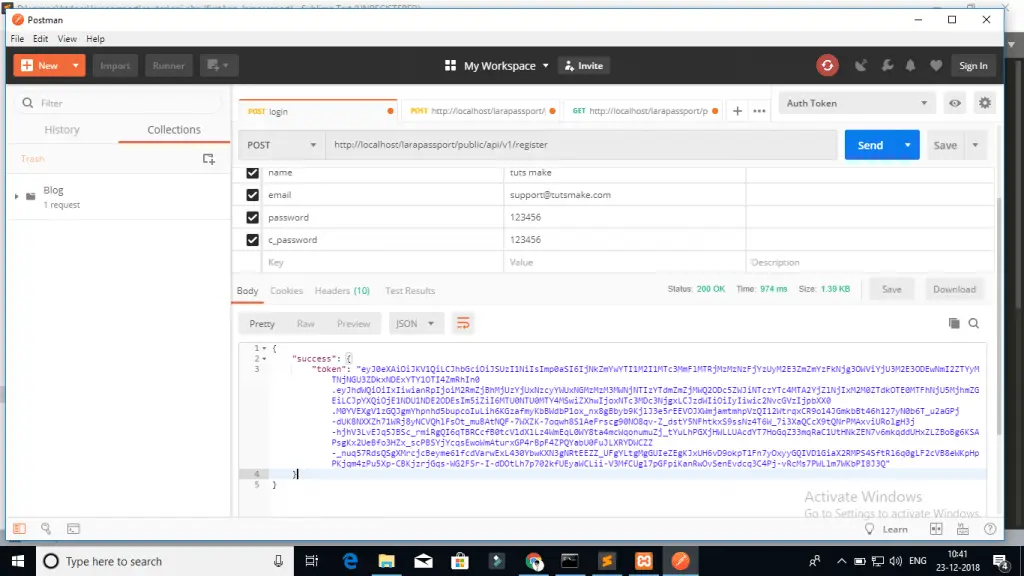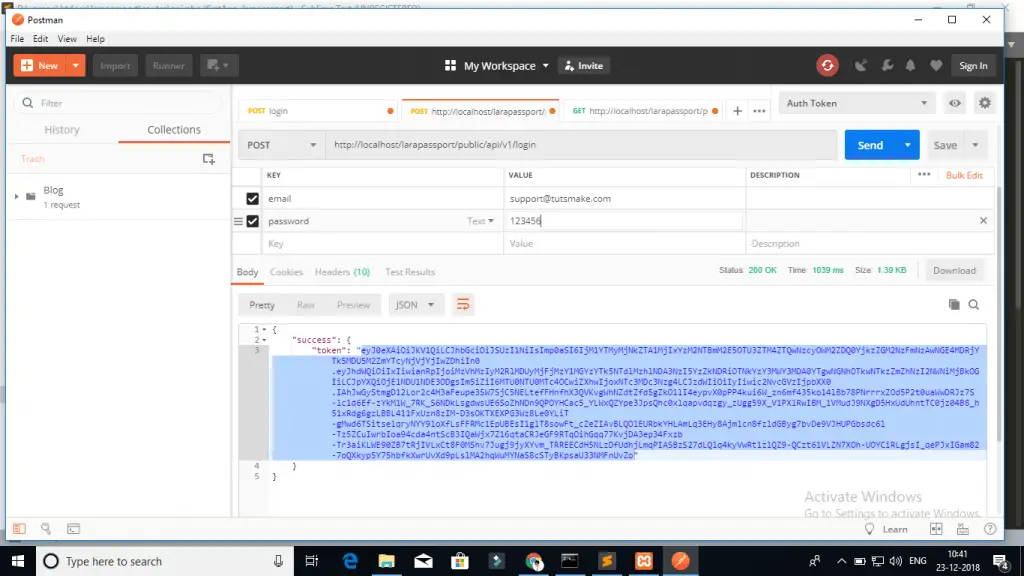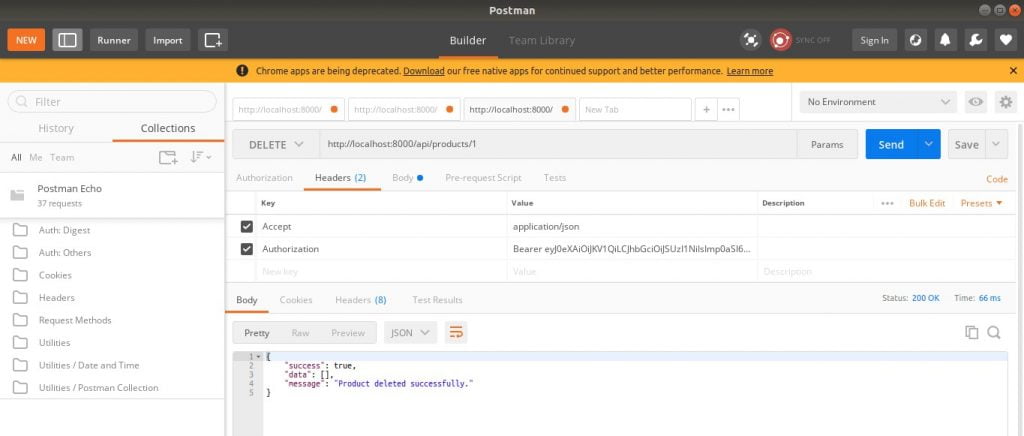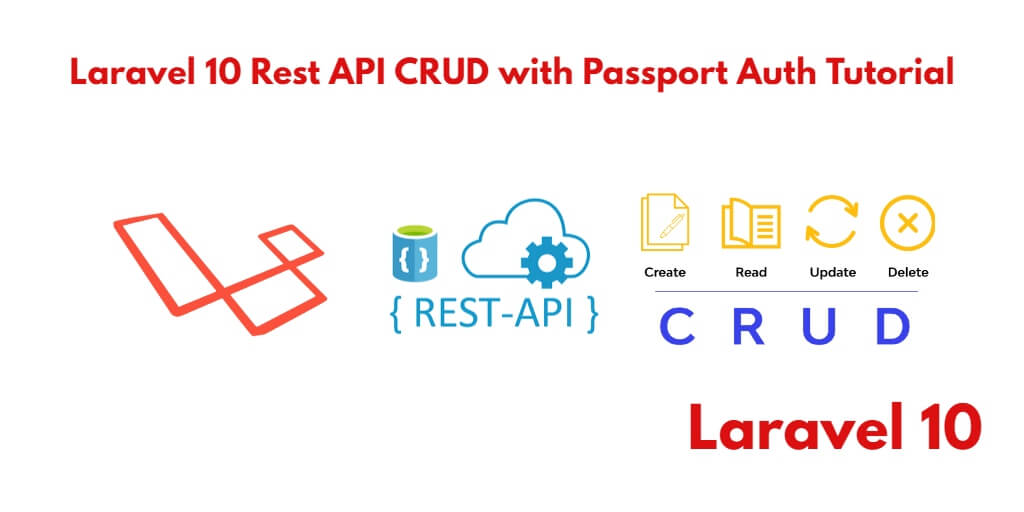If you’re interested in creating RESTful APIs using Laravel 10 for your web application, you’ve come to the right place. In this tutorial, you will learn the process of building a REST API CRUD (Create, Read, Update, Delete) functionality in a Laravel 10 web application with Passport authentication.
In this tutorial guide, you will gain a solid understanding of how to build robust and secure CRUD REST APIs using Laravel’s powerful features and test in postman application.
Laravel 10 CRUD REST API Tutorial Example
By using the following steps, you can create crud rest APIs in laravel 10 apps with passport auth and test in postman app:
- Step 1: Create New Laravel 10 Project
- Step 2: Setup Database with Laravel Project
- Step 3: Install Passport Auth
- Step 4: Setup Passport Auth with Model
- Step 5: Create Migration and Model
- Step 6: Run Migration
- Step 7: Define Routes
- Step 8: Create Controller File
- Step 9: Test Laravel 10 REST API CRUD Project in Postman
Step 1: Create New Laravel 10 Project
First of all, Open command prompt or terminal.
Then execute the following command into it download and install Laravel 10 project on your server:
composer create-project --prefer-dist laravel/laravel blog
Step 2: Setup Database with Laravel Project
Once you have installed laravel project in your server. Now you need to setup database with laravel project.
So, Navigate root directory of your installed laravel restful authentication api with passport tutorial project. And open .env file. Then add the database details as follow:
DB_CONNECTION=mysql DB_HOST=127.0.0.1 DB_PORT=3306 DB_DATABASE=here your database name here DB_USERNAME=here database username here DB_PASSWORD=here database password here
Step 3: Install Passport Auth
Once you have setup database with laravel project. Now, you need to execute the following command on terminal or cmd to install passport package:
composer require laravel/passport
Once you have installed passport package in laravel project. Now you need to configure it with laravel project.
So, Open config/app.php and add the bellow code into it:
// config/app.php 'providers' =>[ Laravel\Passport\PassportServiceProvider::class, ],
Now, you need to install laravel to generate passport encryption keys. This command will create the encryption keys needed to generate secure access tokens:
php artisan passport:install
Step 4: Setup Passport Auth with Model
In this step, Navigate to App/Models directory and open User.php file. Then update the following code into User.php:
<?php
namespace App\Models;
use Illuminate\Contracts\Auth\MustVerifyEmail;
use Illuminate\Database\Eloquent\Factories\HasFactory;
use Illuminate\Foundation\Auth\User as Authenticatable;
use Illuminate\Notifications\Notifiable;
use Laravel\Passport\HasApiTokens;
class User extends Authenticatable
{
use Notifiable, HasApiTokens;
/**
* The attributes that are mass assignable.
*
* @var array
*/
protected $fillable = [
'name', 'email', 'password',
];
/**
* The attributes that should be hidden for arrays.
*
* @var array
*/
protected $hidden = [
'password', 'remember_token',
];
/**
* The attributes that should be cast to native types.
*
* @var array
*/
protected $casts = [
'email_verified_at' => 'datetime',
];
}
Next Register passport routes in App/Providers/AuthServiceProvider.php, Go to App/Providers/AuthServiceProvider.php and update this line => Register Passport::routes(); inside of boot method:
<?php
namespace App\Providers;
use Laravel\Passport\Passport;
use Illuminate\Support\Facades\Gate;
use Illuminate\Foundation\Support\Providers\AuthServiceProvider as ServiceProvider;
class AuthServiceProvider extends ServiceProvider
{
/**
* The policy mappings for the application.
*
* @var array
*/
protected $policies = [
'App\Model' => 'App\Policies\ModelPolicy',
];
/**
* Register any authentication / authorization services.
*
* @return void
*/
public function boot()
{
$this->registerPolicies();
}
}
Next, Navigate to config/auth.php and open auth.php file. Then Change the API driver to the session to passport. Put this code ‘driver’ => ‘passport’, in API:
[
'web' => [
'driver' => 'session',
'provider' => 'users',
],
'api' => [
'driver' => 'passport',
'provider' => 'users',
],
],
Step 5: Create Migration and Model
In this step, open terminal and run the following command to create product model and migration file:
php artisan make:model Product -m
After that, navigate to database/migrations directory and open create_products_table.php file. Then update the following code into it:
<?php
use Illuminate\Support\Facades\Schema;
use Illuminate\Database\Schema\Blueprint;
use Illuminate\Database\Migrations\Migration;
class CreateProductsTable extends Migration
{
/**
* Run the migrations.
*
* @return void
*/
public function up()
{
Schema::create('products', function (Blueprint $table) {
$table->bigIncrements('id');
$table->string('name');
$table->text('detail');
$table->timestamps();
});
}
/**
* Reverse the migrations.
*
* @return void
*/
public function down()
{
Schema::dropIfExists('products');
}
}
Then add fillable property in product.php file, so navigate to app/models directory and open product.php file and update hte following code into it:
<?php
namespace App\Models;
use Illuminate\Database\Eloquent\Factories\HasFactory;
use Illuminate\Database\Eloquent\Model;
class Product extends Model
{
/**
* The attributes that are mass assignable.
*
* @var array
*/
protected $fillable = [
'name', 'detail'
];
}
Step 6: Run Migration
In this step, you need to do migration using the bellow command. This command creates tables in your database:
php artisan migrate
Step 7: Define Routes
In this step, create rest API auth and crud operation routes.
So, navigate to the routes directory and open api.php. Then update the following routes into api.php file:
use App\Http\Controllers\API\PassportAuthController;
use App\Http\Controllers\API\ProductController;
Route::post('register', [PassportAuthController::class, 'register']);
Route::post('login', [PassportAuthController::class, 'login']);
Route::middleware('auth:api')->group(function () {
Route::get('get-user', [PassportAuthController::class, 'userInfo']);
Route::resource('products', [ProductController::class]);
});
Step 8: Create Controller File
In this step, Create a controllers name PassportAuthController and ProductController.
So, open your cmd or terminal and execute the following command into it:
php artisan make:controller Api\PassportAuthController php artisan make:controller Api\ProductController
After that, Create some authentication methods in PassportAuthController.php. So navigate to app/http/controllers/API directory and open PassportAuthController.php file. And, update the following methods into your PassportAuthController.php file:
<?php
namespace App\Http\Controllers\API;
use App\Http\Controllers\Controller;
use Illuminate\Http\Request;
use App\Models\User;
class AuthController extends Controller
{
/**
* Registration Req
*/
public function register(Request $request)
{
$this->validate($request, [
'name' => 'required|min:4',
'email' => 'required|email',
'password' => 'required|min:8',
]);
$user = User::create([
'name' => $request->name,
'email' => $request->email,
'password' => bcrypt($request->password)
]);
$token = $user->createToken('Laravel8PassportAuth')->accessToken;
return response()->json(['token' => $token], 200);
}
/**
* Login Req
*/
public function login(Request $request)
{
$data = [
'email' => $request->email,
'password' => $request->password
];
if (auth()->attempt($data)) {
$token = auth()->user()->createToken('Laravel8PassportAuth')->accessToken;
return response()->json(['token' => $token], 200);
} else {
return response()->json(['error' => 'Unauthorised'], 401);
}
}
public function userInfo()
{
$user = auth()->user();
return response()->json(['user' => $user], 200);
}
}
Next, Create rest api crud methods in ProductController.php. So navigate to app/http/controllers/API directory and open ProductController.php file. And, update the following methods into your ProductController.php file:
<?php
namespace App\Http\Controllers\API;
use App\Http\Controllers\Controller;
use App\Models\Product;
use Illuminate\Http\Request;
use Validator;
class ProductController extends Controller
{
/**
* Display a listing of the resource.
*
* @return \Illuminate\Http\Response
*/
public function index()
{
$products = Product::all();
return response()->json([
"success" => true,
"message" => "Product List",
"data" => $products
]);
}
/**
* Store a newly created resource in storage.
*
* @param \Illuminate\Http\Request $request
* @return \Illuminate\Http\Response
*/
public function store(Request $request)
{
$input = $request->all();
$validator = Validator::make($input, [
'name' => 'required',
'detail' => 'required'
]);
if($validator->fails()){
return $this->sendError('Validation Error.', $validator->errors());
}
$product = Product::create($input);
return response()->json([
"success" => true,
"message" => "Product created successfully.",
"data" => $product
]);
}
/**
* Display the specified resource.
*
* @param int $id
* @return \Illuminate\Http\Response
*/
public function show($id)
{
$product = Product::find($id);
if (is_null($product)) {
return $this->sendError('Product not found.');
}
return response()->json([
"success" => true,
"message" => "Product retrieved successfully.",
"data" => $product
]);
}
/**
* Update the specified resource in storage.
*
* @param \Illuminate\Http\Request $request
* @param int $id
* @return \Illuminate\Http\Response
*/
public function update(Request $request, Product $product)
{
$input = $request->all();
$validator = Validator::make($input, [
'name' => 'required',
'detail' => 'required'
]);
if($validator->fails()){
return $this->sendError('Validation Error.', $validator->errors());
}
$product->name = $input['name'];
$product->detail = $input['detail'];
$product->save();
return response()->json([
"success" => true,
"message" => "Product updated successfully.",
"data" => $product
]);
}
/**
* Remove the specified resource from storage.
*
* @param int $id
* @return \Illuminate\Http\Response
*/
public function destroy(Product $product)
{
$product->delete();
return response()->json([
"success" => true,
"message" => "Product deleted successfully.",
"data" => $product
]);
}
}
Then open command prompt and run the following command to start developement server:
php artisan serve
Step 9: Test Laravel 10 REST API CRUD Project in Postman
Now, open your postman app and call above create crud apis with auth apis in postman app: is as following:
1 – Laravel Register Rest API :

2 – Login API :

Next Step, you will call getUser, create product, list product, edit product, and delete product APIs, In this apis need to pass the access token as headers:
‘headers’ => [ ‘Accept’ => ‘application/json’, ‘Authorization’ => ‘Bearer ‘.$accessToken, ]
3 – Product List API
- Method:- GET
- URL:- http://127.0.0.1:8000/api/products

4 – Product Create API
- Method:- POST
- URL:- http://127.0.0.1:8000/api/products

5 – Product Fetch API
- Method:- GET
- URL :- http://127.0.0.1:8000/api/products/{id}

6 – Product Update API
- Method:- PUT
- URL :- http://127.0.0.1:8000/api/products/{id}

7 – Product Delete API
- Method:- DELETE
- URL :- http://127.0.0.1:8000/api/products/{id}

Conclusion
Laravel 10 restful CRUD APIs with passport auth tutorial, you have learned how to build rest CRUD APIs with passport auth in Laravel 10 app. And as well as how to call this APIs on postman app.
Recommended Laravel Posts
If you have any questions or thoughts to share, use the comment form below to reach us.

Hi,
I ran into some issues while performing Step 7:
vendor\laravel\framework\src\Illuminate\Routing\ResourceRegistrar.php:630
Same thing here. I believe that the you are using Windows. Thus, the backslash (\). For Mac or Linux, use:
php artisan make:controller Api/PassportAuthController
php artisan make:controller Api/ProductController
Also, when creating the PassportAuthController, make you use this as the class name, and not AuthController,.